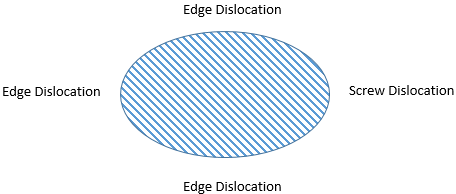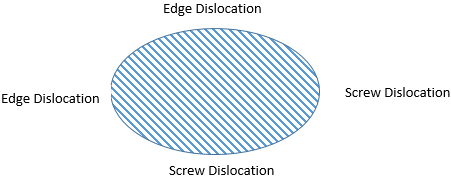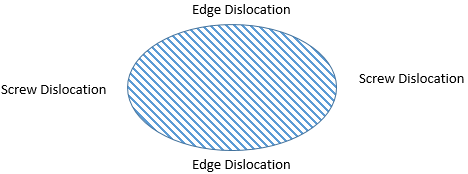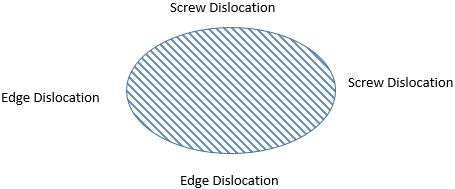This set of Mechanical Metallurgy Multiple Choice Questions & Answers (MCQs) focuses on “Burger Vector & the Dislocation Loop”.
1. Single Dislocation can be physically seen with ________________
a) optical microscope
b) x-ray diffraction
c) scanning electron microscope
d) transmission electron microscope
View Answer
Explanation: The size and width of dislocation are in the range of nanometers. So the only possible way to look at a dislocation is by the transmission electron microscope.
2. Etch pit technique of dislocation detection is based on ___________
a) chemical method
b) physical Method
c) mechanical method
d) analytical method
View Answer
Explanation: In the etch-pit technique, the surface of the material is etched with acid. The point where dislocation interacts with the surface have higher energy and react with acid more actively than the rest of the surface, which appears as black pitch on the surface.
3. The method of detecting dislocations by forming a visible precipitate along the dislocation lines is known as ____________ the small amount of impurity is intensely added to form the precipitate after heat treatment.
a) decoration
b) etching
c) trimming
d) dressing
View Answer
Explanation: The Decoration technique was first used by Hedges and Mitchell’ to decorate dislocations in AgBr with photolytic silver. It has been used in many ionic crystals, such as AgCI, NaC1, KC1, and CaF2.
4. The thickness of the analysis sample used in the Transmission electron microscope is in order of ______
a) meters
b) millimeters
c) micrometers
d) nanometres
View Answer
Explanation: In TEM High energy electron beam is passed through the sample. The thickness of the sample where analysis needs to be done should in order of a few hundreds of nanometres. Because the depth is high, electron will not pass through the sample.
5. Which of the following phenomena is not associated with dislocation?
a) Stacking fault
b) Lomer-Cottrell barrier
c) Frank-reed source
d) Pourbix curve
View Answer
Explanation: The Stacking fault is associated with a partial dislocation, Lomer-Conttrell barrier is interlocking of dislocation, Frank –reed source is the generation of dislocation. But the Pourbix diagram is related to corrosion of the material.
6. Which of the given characterization techniques has the highest resolution?
a) X-ray microscopy
b) Optical microscopy
c) Scanning electron microscopy
d) Field ion microscopy
View Answer
Explanation: The field-ion microscope is an ultimate technique for observing defect structure with the resolution in the range of 2 to 3 A (= 0.2 to 0.3 nm) and with this resolution, individual atoms may be distinguished.
7. The Burgers vector b is the vector which defines the magnitude and direction of slip. For a pure edge dislocation, the Burgers vector is perpendicular to the dislocation line, while for a pure screw dislocation, the Burgers vector is parallel to the dislocation line.
a) True
b) False
View Answer
Explanation: If we draw a complete circuit around a dislocation and non-dislocation region in the lattice, the missing direction in dislocation region will indicate the burger vector.
8. Select the correct option:
| Dislocation property | Edge dislocation | Screw dislocation |
|---|---|---|
| Relationship between dislocation parallel line and burger vector | perpendicular | parallel |
| Slip direction | A | B | The direction of the dislocation line movement relative to slip direction | C | D |
a) A – parallel to burger vector; B – parallel to burger vector; C – parallel; D – Perpendicular
b) A – parallel to burger vector; B – perpendicular to burger vector; C – parallel; D – Perpendicular
c) A – parallel to burger vector; B – parallel to burger vector; C – Perpendicular; D – parallel
d) A – parallel to burger vector; B – perpendicular to burger vector; C – Perpendicular; D – parallel
View Answer
Explanation:
| Dislocation property | Edge dislocation | Screw dislocation |
|---|---|---|
| Relationship between dislocation parallel line and burger vector | perpendicular | parallel |
| Slip direction | parallel to burger vector | parallel to burger vector |
| Direction of dislocation line movement relative to slip direction | parallel | perpendicular |
In Pure edge dislocation, the Burgers vector is perpendicular to the dislocation line; while for a pure screw dislocation, the Burgers vector is parallel to the dislocation line.
9. It is possible that the dislocation will end inside the crystal without interacting with free surface or forming dislocation loop.
a) True
b) False
View Answer
Explanation: The dislocation represents the boundary between the slipped and unslipped region of a crystal, and the topographic considerations require that it either must be a closed loop or else must end at the free surface of a crystal or a grain boundary.
10. Which of the following diagram is the correct representation of the dislocation loop?
a) 
b) 
c) 
d) 
View Answer
Explanation: A dislocation loop is combination of edge dislocation and screw dislocation. The opposite end of the loop are either pure edge type or pure screw type, hence the extreme faces will have the same type of dislocation structure.
11. A dislocation with burger vector equal to one lattice spacing is said to be a dislocation of __________
a) unit strength
b) perfect edge
c) ideal screw
d) universal lattice
View Answer
Explanation: A dislocation with burger vector equal to one lattice spacing is said to be a dislocation of unit strength. That is because during slip in a single step, the dislocation will move by lattice parameter of crystal.
12. Is it possible to have dislocation with strength larger than the dislocation of unit strength?
a) True
b) False
View Answer
Explanation: A dislocation with a Burgers vector equal to one lattice spacing is said to be a dislocation of unit strength. Because of energy considerations, dislocations with strengths larger than unity are generally unstable and dissociate into two or more dislocations of lower strength.
13. Strain energy of dislocation with burger vector (b) is proportional to ______
a) b
b) b2
c) b3
d) b1/2
View Answer
Explanation: The strain energy of dislocation is directly proportional to the square of the burger vector. The average energy of dislocation is defined as:
=>E = Gb2/2 ; Where G is shear modulus.
14. A dislocation with Burger vector b1 will dissociate into two partial dislocations of burger vector b2 and b3 respectively;
b1 -> b2 + b3
b1, b2, b3 are magnitude of burger vectors.
So the reaction will occur only if __________
a) b1 > b2 + b3
b) b1 > b22 + b32
c) b12 > b22 + b32
d) b12 > b2 + b3
View Answer
Explanation: The criterion for deciding whether or not dissociation will occur is based on the fact that the strain energy of dislocation is proportional to the square of its Burgers vector. Therefore, the dissociation reaction b1 → b2 + b3 will occur when b12 > b22 + b32, but not b12 < b22 + b32.
15. Determine whether dislocation reaction is feasible or not?
b1 = b2+ b3
a/6[0 1 1]->a/6[1 2 -1]+a/6[-1 -1 2]
a) Reaction is not balanced and not feasible
b) Reaction is balanced but not feasible
c) Reaction not balance but feasible
d) Reaction is balanced and feasible
View Answer
Explanation: multiple 1/6 inside the bracket and check the x, y, z components of reaction of right side:
x-components = (1/6)-(1/6) =0
y-components = (2/6)-(1/6) =1/6
z-components = (-1/6)+(2/6) =1/6
So the reaction will be a[0 1/6 1/6]
->a/6[0 1 1] So the reaction is balanced:
Now to check the feasibility the condition is
->b12 > b22 + b32
->b1 = a/6 [02+12+12]1/2 = a/3√2
->b2 = a/6 [12+22+(-1)2]1/2 = a/√6
->b3 = a/6 [(-1)2+(-1)2+(2)2]1/2 = a/√6
So b2+b3 = 2a/√6 = √(2/3)a
So here b12 < b22+b32
So the reaction is not feasible.
Sanfoundry Global Education & Learning Series – Mechanical Metallurgy.
To practice all areas of Mechanical Metallurgy, here is complete set of 1000+ Multiple Choice Questions and Answers.
If you find a mistake in question / option / answer, kindly take a screenshot and email to [email protected]
- Practice Metallurgical Engineering MCQs
- Apply for Metallurgical Engineering Internship
- Check Metallurgical Engineering Books
- Check Mechanical Metallurgy Books
